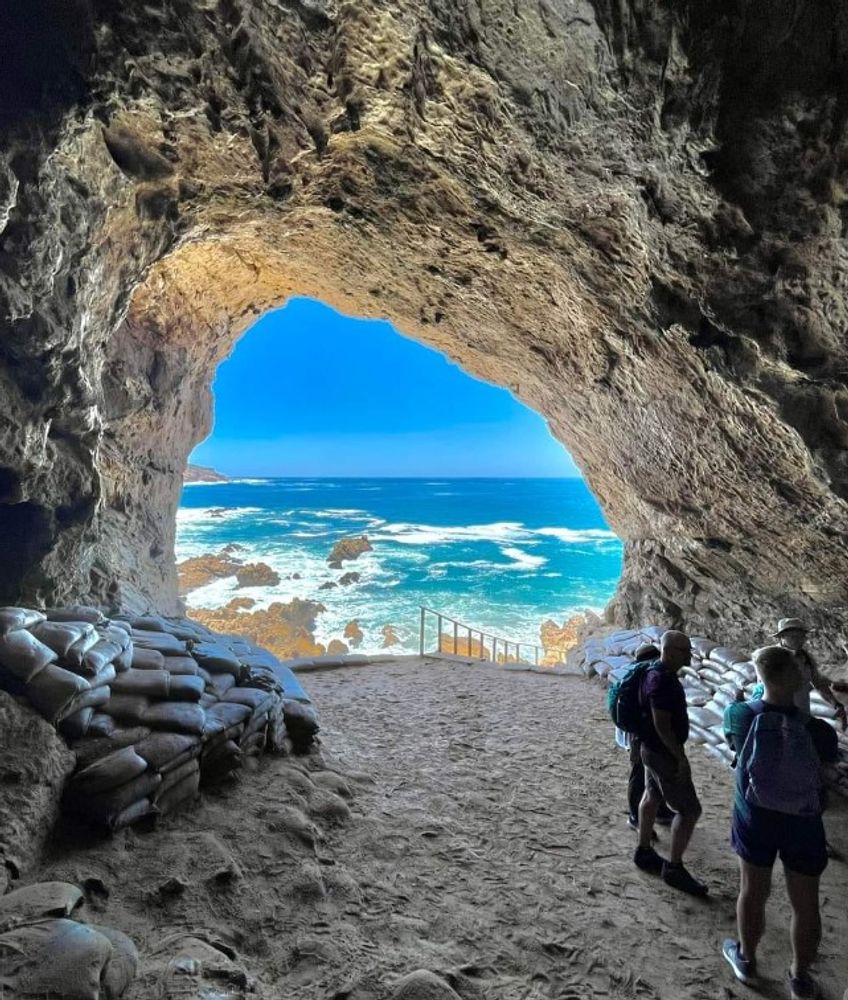Pinnacle Point Cave's History & World Heritage Site
DNA research has shown that all humans alive today descend from a small population that lived between 150,000 and 200,000 years ago. Archaeological research has shown that at least some of those people lived in Mossel Bay...
Allow us to introduce you to the Pinnacle Point Site Complex - the place that’s revealed among the earliest evidence for modern human behaviour. This short, rugged stretch of South African coastline is not only breathtakingly spectacular, it is also home to some of the most significant archaeological discoveries ever made regarding the origins of all people alive on earth today.
The potential archaeological value of the Pinnacle Point Site Complex was initially identified in 1997 by Jonathan Kaplan and Peter Nilssen during an Archaeological Impact Assessment for the broader Environmental Impact Assessment undertaken for the golf course, residential, and casino development. In 1999 Dr Nilssen (Iziko - South African Museum) introduced Prof. Curtis Marean (Arizona State University, USA) to the sites and in 2000 they co-founded the Mossel Bay Archaeology Project. Trial excavations in 2000 were very successful and archaeological investigations under the leadership of Prof. Marean continue to this day. Research into ancient climates and environments became an integral part of the research project (dubbed SACP4) in 2005 and today it is one of the best funded projects of its kind worldwide.
Modern human behaviour 160,000 years ago - deserving of World Heritage Site status?
The main archaeological discoveries were published in the leading scientific journals, Science and Nature. At the moment, Cave 13B contains some of the earliest evidence for modern human behaviour in the world, dated to 160 000 years ago. The Pinnacle Point Site Complex was declared a Provincial Heritage Site in 2012 and on 26 July 2024 is was inscribed as a UNESCO World Heritage Site (WHS).
Inscribed as the "Pinnacle Point Site Complex (PPSC)", it includes all sites within the WHS boundary, but the primary archaeological sites contributing to WHS recognition are PP13B and PP5-6N & PP5-6S (north and south).
"The sites are important to understanding when modern human behaviours and culture evolved. This is important because culture is the technological and symbolic system modern humans uniquely use to adapt to their environment. Its origin is one of the great research questions in science" (Marean 2024 pers. comm.).
Cave PP13B was occupied by humans from ~160,000 to 90,000 years ago, and sealed by a dune from ~90 ka (ka = thousands of years ago) until ~40 ka.
PP5-6N is a rock shelter occupied by humans from ~100 to 50 ka, at which time the rock shelter is filled with sediments.
Cave PP5-6S has a short but very well-preserved human occupation dating from ~120 to 110 ka. It is sealed by a dune ~110 ka. While only test-excavated, it is the research project's target for the next major excavation.
Notably, together, these sites provide the longest record of coastal resource use in all of Africa, and, PP13B is the only site in coastal Africa with sediments older than ~120 ka, the time at which we think the modern human lineage appeared (~200 to 150 ka).
PP13B documents the world’s earliest evidence for humans eating sea foods ~160 ka. The presence of whale barnacles suggests they scavenged from beached whales. PP13B contains the earliest evidence for people modifying and working pigments, in this case red ochre. This was published in: C. W. Marean, M. Bar-Matthews, J. Bernatchez, E. Fisher, P. Goldberg, A. I.R. Herries, Z. Jacobs, A. Jerardino, P. Karkanas, T. Minichillo, P. J. Nilssen, E. Thompson, I. Watts, and H. M. Williams. (2007). Early human use of marine resources and pigment in South Africa during the Middle Pleistocene. Nature 449: 905-908, plus 44 page on-line supplementary information.
PPSC documents the world’s oldest evidence for pyrotechnology, in this case heating stone (silcrete) to improve its fracturing qualities for stone tool production. At PP13B there is very sporadic evidence for this dating to ~160,000 years ago, but at PP5-6N there is substantial evidence for this technology becoming the dominant technology by about ~70 ka. The prior earliest evidence for this technology was ~25 ka in France. This was published in: K. S. Brown, C. W. Marean, A. I. R. Herries, Zenobia Jacobs, C. Tribolo, D. Braun, D. L. Roberts, M. C. Meyer, and J. Bernatchez. (2009). Fire as an Engineering Tool of Early Modern Humans. Science 325:859-862, plus 35 page on-line supplementary material.
PP5-6N documents the earliest evidence for a new advanced technology called microlithic technology dated to ~70 ka. These are very small (=micro) stone tools (=lithic). The prior widely accepted earliest evidence was ~40 ka. Microlithic technology is good proxy evidence for the use of advanced projectile weapons, such as bow and arrow. This was published in: Kyle S. Brown, Curtis W. Marean, Zenobia Jacobs, Benjamin J. Schoville, Simen Oestmo, Erich C. Fisher, Jocelyn Bernatchez, Panagiotis Karkanas, and Thalassa Matthews. (2012). An Early and Enduring Advanced Technology Originating 71,000 Years Ago in South Africa. Nature 491: 590-593, plus 35 page on-line supplementary information. doi:10.1038/nature11660.
PP5-6N was the first site to show that humans thrived through the Mt. Toba super-volcanic eruption dated ~74 ka. It was widely thought that this volcanic eruption nearly drove humans extinct. We showed that humans here on the coast thrived through this catastrophe. This was published in: Eugene I. Smith, Zenobia Jacobs, Racheal Johnsen, Minghua Ren, Erich C. Fisher, Simen Oestmo, Jayne Wilkins, Jacob A. Harris, Panagiotis Karkanas, Shelby Fitch, Amber Ciravolo, Deborah Keenan, Naomi Cleghorn, Christine S. Lane, Thalassa Matthews and Curtis W. Marean. (2018) Humans thrived in South Africa through the Toba eruption about 74,000 years ago. Nature doi:10.1038/nature25967.
There are many other important results from the research project – as of March 2024, 100 peer-review scientific papers have been published, many covering climate and environmental change.


